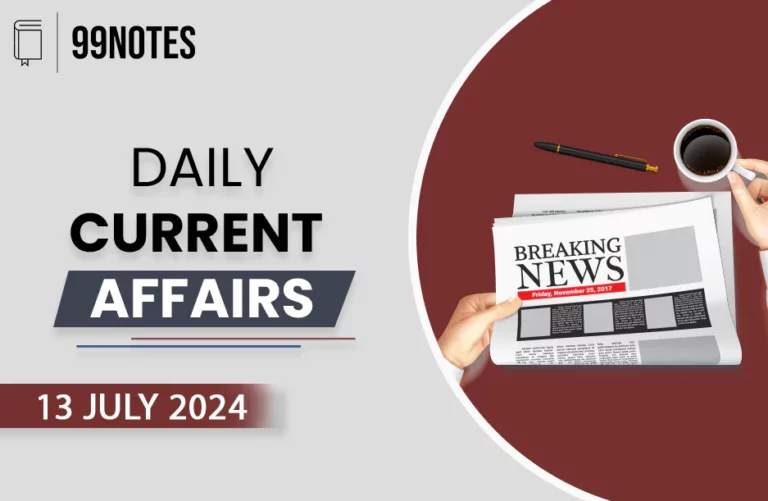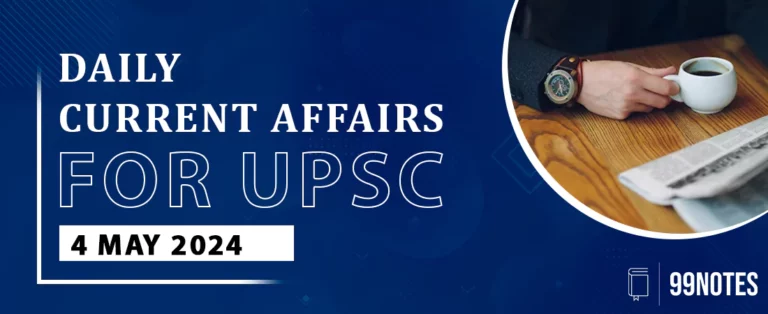30 March 2024 : Daily Current Affairs
Daily Current Affairs
30-March -2024- Top News of the Day
1. Indian Banking Sector Sees Continued Improvement in Asset Quality, GNPA Expected to Reach 2.1% by FY25: Report
|
Topic: GS3 – Indian Economy – This topic is relevant for both Prelims and Mains as this analysis on GNPA trends provides insights into the effectiveness of regulatory measures and policy interventions aimed at addressing banking sector challenges. |
| Context: |
|
More about the news:
Impact of RBI’s Comprehensive Exercise:
- The Reserve Bank of India (RBI) initiated a comprehensive exercise in the middle of the last decade, instructing banks to classify certain stressed assets as Non-Performing Assets (NPAs) to ensure accurate representation of balance sheets.
- This move led to a surge in GNPA to 11.2 percent in FY18 from 3.8 percent in FY14, primarily due to the Asset Quality Review (AQR) process of 2015-16.
Trend of Improvement in Asset Quality:
- Since FY19, GNPAs have shown a consistent improvement, reaching a decadal low of 3.9 percent in FY23 and standing at 3 percent in the December quarter of FY24.
- Factors contributing to this improvement include recoveries, higher write-offs by banks, lower slippages, and the sale of distressed assets to asset reconstruction companies.
Sectoral Analysis of GNPA:
- From a sectoral perspective, the GNPA ratio in agriculture reduced to 7 percent in September 2023 compared to 10.1 percent in March 2020.
- Similarly, the industrial sector reported a GNPA ratio of 4.2 percent in September 2023, significantly lower than 14.1 percent in March 2020 and 22.8 percent in March 2018.
- Industrial GNPAs declined due to corporate deleveraging, resolutions, and write-offs, although challenges persist in gems and jewelry and construction sub-sectors.
Retail Loan GNPA and Monitoring Challenges:
- The retail loan GNPA stood at 1.3 percent in September 2023, down from 2 percent in March 2020. However, stress in this segment primarily arises from unsecured loans, credit card receivables, and education loans.
- The agency highlights the need for continued monitoring of unsecured personal loans and restructured accounts.
Comparison with Global Trends:
- Despite the declining trend in GNPA, loss assets in India remain comparatively higher than in other countries.
- Advanced economies have maintained healthy asset quality due to continued deleveraging, institutional and government intervention, and active market practices to manage delinquent assets.
- While delinquencies in the European Union have reached their lowest levels since the global financial crisis, GNPA ratios remain relatively elevated in Russia.
Conclusion:
- The analysis underscores the ongoing improvement in India’s banking sector regarding asset quality, with concerted efforts aimed at reducing NPAs across sectors.
- However, challenges persist, necessitating continuous monitoring and proactive measures to sustain the positive momentum and align with global standards of asset quality management.
| What is a Non-Performing Asset? |
|
About:
|
|
PYQ: Which of the following statements best describes the term ‘Scheme for Sustainable Structuring of Stressed Assets (S4A)’, recently seen in the news? (2017) (a) It is a procedure for considering ecological costs of developmental schemes formulated by the Government. (b) It is a scheme of RBI for reworking the financial structure of big corporate entities facing genuine difficulties. (c) It is a disinvestment plan of the Government regarding Central Public Sector Undertakings. (d) It is an important provision in ‘The Insolvency and Bankruptcy Code’ recently implemented by the Government. Ans: (b) |
| Practice Question: Discuss the trends and implications of Gross Non-Performing Assets (GNPA) in the Indian banking sector, as outlined in recent reports. Evaluate the effectiveness of regulatory measures and policy interventions in addressing NPAs and improving asset quality. (250 words/15 m) |
2. Government Procurement through GeM Portal Doubles to Rs 4 Lakh Crore in Current Fiscal Year
|
Topic: GS2 – Governance – Important aspects of governance– E-governance – applications, models, successes, limitations and potential; This topic is relevant for both Prelims and Mains in the context of knowing facts about the GeM portal’s role in government procurement which reflects broader economic policies and reforms aimed at promoting transparency, competitiveness, and ease of doing business. |
| Context: |
|
More about the news:
Objectives and Background of GeM Portal:
- Launched in 2016, the GeM portal aims to introduce transparency and competitiveness in procurement activities, offering Central ministries and departments a platform for online purchases of goods and services.
- It has emerged as one of the world’s largest platforms for government procurement, boasting over 63,000 government buyer organizations and more than 6.2 million sellers and service providers.
- GeM ranks third globally, following South Korea’s KONEPS and Singapore’s GeBIZ.
Scope and Participants in GeM Portal:
- Various government entities, including government departments, ministries, public sector units, state governments, and central armed police forces, are permitted to conduct transactions through the GeM portal.
- The portal facilitates transactions across a diverse array of product categories, ranging from office stationery to vehicles, with major categories including automobiles, computers, and office furniture.
Regional Adoption and Significant Procurement Orders:
- In the current fiscal year, several states and union territories have demonstrated significant engagement with the GeM portal by placing substantial procurement orders.
- States such as Uttar Pradesh, Gujarat, Maharashtra, Delhi, Madhya Pradesh, Jammu and Kashmir, Odisha, Bihar, Assam, and Uttarakhand have notably utilized the GeM platform for procurement purposes, contributing to the overall increase in transactions.
Conclusion:
- The substantial increase in procurement through the GeM portal underscores its growing significance as a key tool for government procurement in India.
- The portal’s role in promoting transparency, efficiency, and competitiveness in procurement processes is evident from the surge in transactions across goods and services categories.
- Continued adoption and utilization of the GeM platform by various government entities, coupled with efforts to enhance its functionality and accessibility, are poised to further bolster its impact on public procurement practices in the country.
| What are the Features of GeM? |
|
Significance of the GeM Portal:
Major Developments on GeM:
|
| Practice Question: Discuss the significance of the Government e-Market (GeM) portal in revolutionizing public procurement in India. Assess the challenges and opportunities associated with the widespread adoption of GeM across government entities and propose measures to further enhance its effectiveness in facilitating online procurement. (250 words/15 m) |
3. Supreme Court Reconsiders Order to Bury Power Lines in Great Indian Bustard Habitat Amid Feasibility Concerns
|
Topic: GS3 – Environment – Conservation This topic is relevant for both Prelims and Mains in the context of understanding the challenges faced by conservation efforts in mitigating the impact of infrastructure development on wildlife. |
| Context: |
|
More about the news:
Vulnerability to Power Lines:
- Power lines pose a significant risk to all flying birds, but the GIB is particularly vulnerable due to its narrow frontal vision and large size.
- Unlike some birds with panoramic vision, the GIB’s blind areas above its head make it susceptible to collisions with power lines, leading to fatalities.
- A study estimated that power lines in the GIB habitat kill thousands of birds annually, including GIBs.
Legal and Technological Challenges:
- The Supreme Court’s order in April 2021 to bury power lines irrespective of cost factors reflected the urgency of protecting the GIB.
- However, the feasibility of implementing this order has been questioned by the Centre, citing challenges such as transmission losses, maintenance issues, and safety concerns associated with underground cables.
Cost Implications and Infrastructure Development:
- The Centre highlighted the heavy cost implications of burying power lines across large areas of GIB habitat, emphasizing the need to balance conservation goals with infrastructure development.
- While underground cables are considered integral to modern power transmission infrastructure, their adoption depends on factors like reactive compensation requirements and costs compared to overhead systems.
Slow Progress and Alternative Measures:
- Despite the Supreme Court’s order, the implementation of burying power lines has been slow, with only a fraction of designated lines being laid underground.
- Meanwhile, other threats to the GIB, such as free-ranging dogs, pesticide use, and habitat loss, continue to endanger the species.
- Efforts such as captive breeding aim to supplement the wild population, but the priority remains freeing hostile infrastructure from GIB habitat.
Balancing Conservation and Development:
- The debate over protecting the GIB habitat underscores the need to balance conservation efforts with sustainable development goals.
- While renewable energy projects offer promising solutions for addressing India’s power needs, they must be carefully planned to minimize their impact on wildlife habitats.
- Pitting conservation against development goals risks the survival of flagship species like the GIB and threatens the delicate desert ecology.
Future Directions and Recommendations:
- The Supreme Court’s decision to modify the scope of burying power lines in priority GIB areas reflects a pragmatic approach to conservation.
- The expert committee’s recommendations, due by July 31, will play a crucial role in determining the way forward.
- It is imperative to find a balance between protecting endangered species and meeting energy demands, ensuring that infrastructure development does not come at the expense of biodiversity conservation.
| About Great Indian Bustard |
|
|
|
PYQ: Which one of the following groups of animals belongs to the category of endangered species? (2012) (a) Great Indian Bustard, Musk Deer, Red Panda and Asiatic Wild Ass (b) Kashmir Stag, Cheetal, Blue Bull and Great Indian Bustard (c) Snow Leopard, Swamp Deer, Rhesus Monkey and Saras (Crane) (d) Lion-tailed Macaque, Blue Bull, Hanuman Langur and Cheetal Ans: (a) |
| Practice Question: What is the significance of the Great Indian Bustard (GIB) habitat protection issue currently under review by the Supreme Court? How does it reflect the broader challenges in balancing environmental conservation with developmental needs? (250 words/15 m) |
4. India-Ukraine Diplomatic Talks: Commitment to Peace Process amid Ongoing Elections
|
Topic: GS2 – International Relations – Bilateral Relations This topic is relevant for both Prelims and Mains in the context of understanding the dynamics of bilateral relations, conflict resolution mechanisms, and India’s role in global peace efforts. |
| Context: |
|
More about the news:
Challenges and Commitments:
- Given the electoral context, committing to participation in the Swiss summit, especially at a specified government level, poses challenges for New Delhi.
- Nonetheless, India has expressed its willingness to participate at an “appropriate level,” conveying its readiness for engagement in resolving the conflict.
Discussion Highlights:
- During the meeting, Kuleba and Jaishankar discussed various aspects of bilateral relations, regional security dynamics, and global issues.
- Kuleba emphasized building on the dialogue between Ukrainian President Volodymyr Zelenskyy and Prime Minister Narendra Modi, underlining the importance of cooperation between the two nations.
India’s Stance and Humanitarian Assistance:
- Since the onset of the conflict in February 2022, India has extended humanitarian aid to Ukraine, including medical supplies, tents, blankets, and financial assistance for reconstruction efforts.
- Despite maintaining diplomatic neutrality, India has expressed concerns over specific issues such as the Bucha massacre and nuclear threats, urging for international investigations.
Balancing Act and Bilateral Relations:
- India has adopted a nuanced approach in its diplomatic engagements, abstaining from voting against Russia in UN resolutions while emphasizing dialogue and diplomacy as avenues for conflict resolution.
- The meeting between Kuleba and Jaishankar also aimed to revitalize bilateral cooperation and explore avenues for enhancing trade, health, science, and technology collaboration.
Evolving Relations and Past Engagements:
- Kuleba’s visit signifies an evolution in Ukrainian-Indian relations, especially considering India’s past engagements with both Russia and Ukraine amid the conflict.
- Despite tensions, India has sought to maintain dialogue with leaders from both countries, emphasizing the importance of peaceful resolution and sovereign integrity.
Way Forward:
- As Kuleba concludes his visit, the discussions and commitments made during his interactions with Indian officials pave the way for continued engagement and cooperation between India and Ukraine.
- The willingness of both nations to restore bilateral ties and explore new avenues for collaboration underscores their shared commitment to strengthening diplomatic relations amidst global challenges.
| What is the Background of Russia-Ukraine Conflict? |
|
Why Russia invaded Ukraine?
|
|
PYQ: Consider the following pairs: (2023) Area of conflict mentioned in news: Country where it is located 1. Donbas: Syria 2. Kachin: Ethiopia 3. Tigray: North Yemen How many of the above pairs are correctly matched? (a) Only one (b) Only two (c) All three (d) None Answer: (d) |
| Practice Question: Examine the evolving dynamics of India’s diplomatic engagement with Ukraine in the context of the Russia-Ukraine conflict. Assess the implications of India’s stance on the conflict for its foreign policy objectives and international relations. (250 words/15 m) |
5. Notify norms to make movies accessible to disabled persons: HC
|
Topic: GS2 – Social Justice – Vulnerable sections From a UPSC perspective, ensuring film accessibility for persons with disabilities aligns with inclusive policies and legal compliance. |
| Context |
| ● The news pertains to the Delhi High Court directing the Indian government to enforce guidelines for making films accessible to persons with visual and hearing disabilities by July 15. |
Additional information on this news:
- The Delhi High Court has directed the Centre to notify guidelines for making films accessible to persons with hearing and visual disabilities by July 15.
- Accessibility for persons with disabilities is recognized as a legal right, and private parties are obligated to take reasonable measures to ensure greater accessibility.
- The Information and Broadcasting Ministry has drafted guidelines for accessibility standards in cinema halls, which are in the finalization process.
- The court ordered that the guidelines must make accessibility features mandatory and provide a reasonable compliance period for all stakeholders.
- The directive stems from a petition filed by four individuals with visual and hearing disabilities, seeking accessible films.
- Despite the Rights of Persons with Disabilities (RPWD) Act being in place for over five years, many films in India do not cater to disabled persons.
- In October 2019, the Ministry had issued directives to film producers’ associations and the Central Board of Film Certification (CBFC) to incorporate audio description, subtitles, and closed captions in all films.
| Other initiatives by Indian government for disabled people: |
|
● The Rights of Persons with Disabilities Act, 2016, replaced the Persons with Disabilities Act, 1995, to enhance the rights and entitlements of persons with disabilities. ●The Accessible India Campaign (Sugamya Bharat Abhiyan) aims to make public infrastructure and transportation accessible for persons with disabilities. ● The National Action Plan for Skill Development of Persons with Disabilities focuses on skill development and employment opportunities. ● The Sugamya Bharat App provides information on accessible places for persons with disabilities. ● The National Handicapped Finance and Development Corporation provides loans and financial assistance to persons with disabilities for self-employment. ● Financial Support: Schemes like Indira Gandhi National Disability Pension Scheme and Assistance to Disabled Persons for Purchase/Fitting of Aids and Appliances (ADIP) provide financial aid for living expenses and assistive devices. ● Awareness & Inclusion: Schemes like BADHTE KADAM promote community interaction and raise awareness about disability issues. ● The Department of Empowerment of Persons with Disabilities offers various schemes and scholarships for education and skill development. ● The Accessible Elections initiative ensures accessible polling booths and facilitates voting for persons with disabilities during elections. ● Various ministries and departments have specific schemes and initiatives catering to the needs of persons with disabilities, promoting their inclusion and empowerment. |
| Practice Question: Discuss the significance of enforcing film accessibility guidelines for persons with disabilities, emphasizing legal obligations and inclusive policies. (150 Words /10 marks) |
6. Water woes in Kuttanad wetland
|
Topic: GS3 – Environment – Environmental pollution and degradation Understanding the water crisis in Kuttanad aids in comprehending environmental challenges and infrastructure development, crucial for UPSC aspirants. |
| Context |
| ● The news highlights the severe drinking water crisis in Kerala’s Kuttanad region due to pollution, changing weather patterns, and incomplete infrastructure projects. |
Additional information on this news:
- Residents of Kuttanad region in Kerala face severe drinking water scarcity, relying on private water supply due to lack of wells or piped water systems.
- Public taps are often dry, forcing people to spend between ₹1,000 to ₹3,000 monthly on drinking water.
- The region, known for paddy cultivation below sea level, grapples with changing weather patterns, floods, and droughts, exacerbating water woes.
- Water pollution, high salinity, and lack of efficient waste management contribute to the crisis.
- Upper Kuttanad witnesses unprecedented water scarcity, affecting agriculture, fishing, and livelihoods.
- Experts suggest rainwater harvesting systems as a solution, and installing units to mitigate the crisis.
- The Kuttanad drinking water scheme, initiated in 1973, remains incomplete, with slow progress despite government allocations.
- Experts emphasize the need for coordinated water conservation and management efforts to address the acute water shortage in the region.
| Water crisis in South India: |
|
Water crisis in South India: ● Reservoir Levels: As of March, 2024, South Indian reservoirs are at only 43% capacity, compared to 52% last year [The Hindu – 14th March]. This represents a significant drop in stored water. ● City Impact: Major cities like Bengaluru, Hyderabad, and Chennai are all facing water shortages due to low reservoir levels and rising demand [The Hindu]. ● State Variations: The crisis isn’t uniform. Andhra Pradesh has just 22% reservoir storage compared to last year, while Kerala has 35%. Reasons for Water Crisis in South India: ●Depletion of Groundwater: Excessive extraction for agriculture, industries, and urban consumption has led to groundwater depletion. ● Erratic Rainfall Patterns: Variability in monsoon rains due to climate change results in droughts and reduced water availability. ● Deforestation and Soil Erosion: Loss of forest cover and soil erosion decrease water retention capacity, leading to reduced groundwater recharge. ●Unsustainable Agricultural Practices: Inefficient irrigation methods and excessive water-intensive crops contribute to water scarcity. ●Urbanization and Population Growth: Rapid urbanisation and population growth increase water demand, straining existing resources. ● Pollution: Contamination of water bodies due to industrial discharge, agricultural runoff, and untreated sewage reduces water quality. Way Forward to Address the Water Crisis: ● Promote Water Conservation: Encourage efficient water use practices in agriculture, industries, and households. ● Implement Rainwater Harvesting: Mandate rainwater harvesting systems in urban and rural areas to augment water supply. ● Enhance Irrigation Efficiency: Adopt drip irrigation and other water-saving techniques to improve agricultural water use efficiency. ●Recharge Groundwater: Implement measures to enhance groundwater recharge through artificial recharge structures and afforestation. ● Integrated Water Resource Management: Develop comprehensive water management plans considering surface water, groundwater, and rainwater. ● Policy Reforms: Enforce stricter regulations on groundwater extraction, pollution control, and sustainable water use. ● Public Awareness and Participation: Educate communities about the importance of water conservation and involve them in water management initiatives. ●Invest in Infrastructure: Develop infrastructure for water storage, treatment, and distribution to ensure equitable access to clean water. ● Research and Innovation: Invest in research and innovation to develop new technologies for efficient water management and conservation. Addressing the water crisis requires a multi-pronged approach involving policy interventions, community participation, and sustainable practices to ensure water security in South India. |
| PYQ: India is well endowed with fresh water resources. Critically examine why it still suffers from water scarcity. (200 words/12.5m) (UPSC CSE (M) GS-1 2015) |
| Practice Question: Discuss the factors contributing to the water crisis in South India and suggest measures to mitigate the problem. (250 Words /15 marks) |
7. ‘GeM may offer works contracts’
|
Topic: GS2 – Indian Polity – Governance – E-governance Understanding GeM’s expansion aids in digital governance, transparency, and efficient public procurement, vital for UPSC aspirants in policy analysis. |
| Context |
| ● The news highlights Government e-Marketplace’s (GeM) plans to expand its platform to enable bidding for construction projects and implement transparent monitoring mechanisms. |
Additional information on this news:
- The Government e-Marketplace (GeM) plans to seek approval to enable bidding for construction and building projects on its platform.
- GeM aims to implement a transparent monitoring mechanism for assessing the progress of work contracts.
- The platform is undergoing a broader reboot, including a revamp of its online interface to switch to an open Application Programming Interface (API) architecture.
- This upgrade will allow individual departments, States, and local bodies to create customised micro-procurement portals with multi-lingual interfaces and flexibilities for local rules.
- GeM recorded a total gross merchandise value of over ₹4 lakh crore in procurements this year, doubling the previous year’s figure.
- GeM CEO, P. K. Singh, highlighted that the tendering process for work contracts is often time-consuming and faces delays, mainly attracting local contractors.
- Allowing GeM for such projects would enable contractors from different regions to bid and facilitate online monitoring of project progress.
- Milestone-linked payments released electronically and post-contract management features are additional benefits envisioned for contractors.
| More about Government e-Marketplace (GeM): |
|
●Government e-Marketplace (GeM) is an online platform established by the Government of India to facilitate procurement of goods and services by government departments and agencies. ●GeM aims to promote transparency, efficiency, and cost-effectiveness in public procurement processes. ● It provides a single platform for both buyers (government organizations) and sellers (vendors) to conduct transactions. ● GeM covers a wide range of products and services, including office supplies, electronics, vehicles, and consultancy services. ● The platform offers features such as catalog management, price comparison, and online bidding to streamline procurement procedures. ●Sellers need to register on GeM and list their products/services to participate in government tenders and auctions. ● GeM ensures compliance with government regulations and promotes fair competition among vendors. ● It reduces paperwork and manual processes, leading to faster procurement cycles and lower administrative costs. ●GeM also facilitates direct payments to vendors, enhancing transparency and accountability in financial transactions. ● Overall, GeM plays a crucial role in modernizing government procurement practices and promoting digital governance in India. |
| Practice Question: Discuss the significance of Government e-Marketplace (GeM) expansion in enhancing transparency and efficiency in public procurement processes. (250 Words /15 marks) |
For Enquiry

30 Mar 2024 : Daily Answer Writing

30 Mar 2024 : Daily Current Affairs Quiz

30 March 2024 : Daily Current Affairs

30 March 2024 : The Hindu Editorial Notes PDF

30 March 2024 : PIB Summary for UPSC

30 March 2024 : Indian Express Editorial Analysis

DSP Salary Per Month in India- 7th Pay Commission, Perks and Allowance in 2024

Best IAS Coaching in Mukherjee Nagar: Course, Fees, Review, & Contact Details

29 Mar 2024 : Daily Answer Writing

29 Mar 2024 : Daily Current Affairs Quiz
mains answer writing 30 Mar 2024 : Daily Answer Writing Mains Answer Writing
30-March-2024
Q1) Sustained decline in maternal mortality rate (MMR) requires public…
Daily Quiz 30 Mar 2024 : Daily Current Affairs Quiz 30 Mar 2024 : Daily Quiz…
Daily Current Affairs 30 March 2024 : Daily Current Affairs Daily Current Affairs
30-March -2024- Top News of the Day
1. Indian Banking Sector Sees Continued Improvement…
March – The Hindu Editorial 30 March 2024 : The Hindu Editorial Notes PDF The Hindu EDITORIAL
30-March-2024
1. Bonds, big money and an imperfect democracy
Topic: GS2 – Indian…
March 2024 PIB 30 March 2024 : PIB Summary for UPSC PIB Summary for UPSC
30-March -2024
1. ECI’s C-Vigil app a big hit with voters: over 79,000 violations…
Indian Express 30 March 2024 : Indian Express Editorial Analysis Indian Express Editorial Analysis
30-March-2024
1. AFRICA AT THE CENTRE
Topic: GS2 – International…
Blogs Upsc DSP Salary Per Month in India- 7th Pay Commission, Perks and Allowance in 2024 DSP Salary– The starting salary for a DSP as a Pay Matrix Level, DSP corresponds to a monthly salary…
Blogs Upsc Best IAS Coaching in Mukherjee Nagar: Course, Fees, Review, & Contact Details Best IAS Coaching in Mukherjee Nagar
Mukherjee Nagar, Delhi is a place renowned for its educational…
mains answer writing 29 Mar 2024 : Daily Answer Writing Mains Answer Writing
29-March-2024
Q1) The human resource potential of India’s young demography lies…
Daily Quiz 29 Mar 2024 : Daily Current Affairs Quiz 29 Mar 2024 : Daily Quiz…



